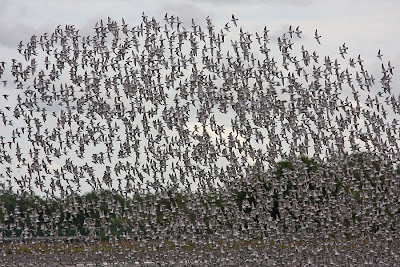Testing My 20 Sounds in One Sound Medley
Posted by
admin
Thursday, November 18, 2010

I was so tempted to test this beautiful idea of putting 20 or more sounds into one thumb drive.
After a very hard thinking I decided to perform the cut and paste. What I did was to compile all the good sounds that are in my collection and select about 3 minutes of the best part. Then arrange in a sequence so that the sound will be continuous and attractive.
Today tested the sound at Kepong KIP BH. Stayed for about 30 minutes to observe the birds reaction.
Not bad. The result was unusual but I better give them sometime to settle down.
I will be visiting the BH regularly to observe the reaction of those birds in the air especially around the BH entrance hole.
If this special sound is good I would like to make it available to all my blog readers.
Those who are excited to see the action at your BH, I have this special offer.
The first 10 readers will get the sound to test at a fraction of the value. First come first serve basis......
All you need to pay is only 150RM and it is yours.
If the sound's effectiveness is good it will be sold at 600 RM
Make you choice and I am sure you will enjoy seeing those birds coming into your BH...
Fully recommended to be one of your collection........
Contact 017 755 1318 for more details.....
Wednesday
Posted by
admin
Monday, October 4, 2010
This week the tides are still not much good for photography - 2.1 and 2.2m all week, but, ever the optimist, I went to see what I could see today. I was also keen to see how the Malaysian Plovers' moult was progressing.
As expected, it was difficult to get close to the birds, but I was able to take some distant shots and do a count. On the construction site, new blue-painted pegs have appeared everywhere - no doubt the forerunners of house foundations. For today anyway, some Barn Swallows were making use of them as flycatching lookout posts, and they were quite approachable as long as I stayed in the car.
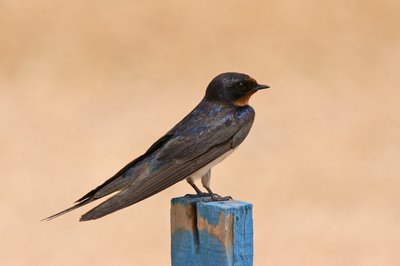
There were one or two stunning pinkish-purple flowers growing out of the sand. Their colours were so vivid I just had to take a photo! If anyone knows the name of this plant, please put it in a comment below this entry!
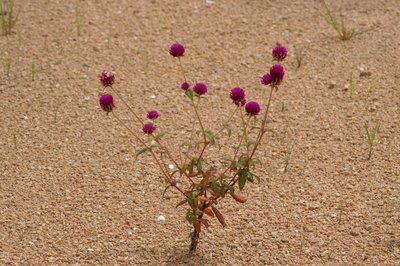
I got a few flight shots of the waders as they were moving around to nab the best spots to feed.

A flock of Red-necked Stints with a lone Broad-billed Sandpiper in there somewhere. See if you can spot it!
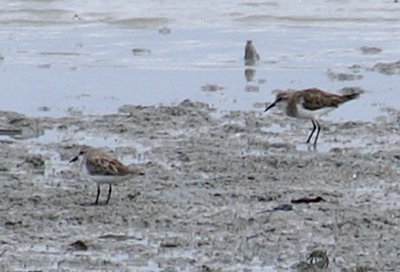
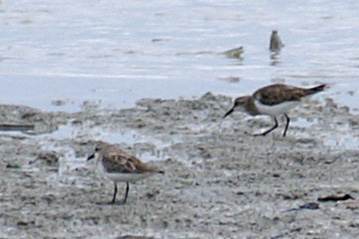
It was nice to find a fairly obvious Little Stint (as Little Stints go!) among the Red-neckeds, but frustrating not to be able to get very close. The most marked feature was the long legs - both the tarsus and tibia seemed longer than Red-neckeds. The bill tapered to quite a fine point and was slightly but noticeably decurved, and the bird showed the distinctive 'round-shouldered' shape and turned up rear end I have noted on other Little Stints. The upperparts were nice and dark (though not as dark as these pictures suggest!) , and the bird had a good breast band. Structurally the bird looked very similar to one seen and photographed earlier in the autumn (see here) and could conceivably be the same bird.
In my attempts to get closer to the waders on the high tide mark I managed to step into a sink-hole in the mud and went in straight up to above my knees! Thankfully the surrounding sand was firm and I was able to pull myself out with the help of my tripod. Amazingly camera, scope and bins survived unharmed! My trousers and shoes weren't so lucky!
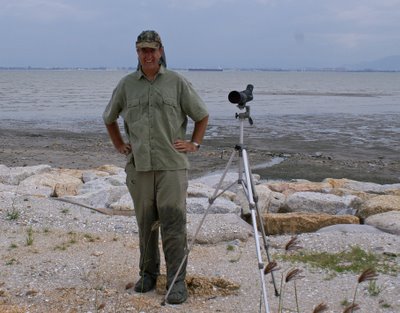

The lengths - or should I say the depths - to which I will go to get my photos!
There were a few more birds today - both in number and variety - than of late. Here's the count:
Pacific Golden Plover 8
Little Ringed Plover 3
Lesser Sand Plover 1
Kentish Plover 19
Malaysian Plover 11
Red-necked Stint 210
Little Stint 1
Broad-billed Sandpiper 2
Curlew Sandpiper 2
Common Redshank 500
Common Greenshank 30
Marsh Sandpiper 10
Whimbrel 1
Total 798
On my way from the site, I came across this confiding 1st winter Brown Shrike. Usually I find Brown Shrikes very shy and unapproachable (Tiger Shrikes, by contrast, are usually quite tame), but this one seemed engrossed in catching prey and wasn't too bothered by my presence (in the car).


It was amazingly successful at catching various bugs, and had a very high strike rate - probably about 80%.
Read more »
As expected, it was difficult to get close to the birds, but I was able to take some distant shots and do a count. On the construction site, new blue-painted pegs have appeared everywhere - no doubt the forerunners of house foundations. For today anyway, some Barn Swallows were making use of them as flycatching lookout posts, and they were quite approachable as long as I stayed in the car.

There were one or two stunning pinkish-purple flowers growing out of the sand. Their colours were so vivid I just had to take a photo! If anyone knows the name of this plant, please put it in a comment below this entry!

I got a few flight shots of the waders as they were moving around to nab the best spots to feed.

A flock of Red-necked Stints with a lone Broad-billed Sandpiper in there somewhere. See if you can spot it!


It was nice to find a fairly obvious Little Stint (as Little Stints go!) among the Red-neckeds, but frustrating not to be able to get very close. The most marked feature was the long legs - both the tarsus and tibia seemed longer than Red-neckeds. The bill tapered to quite a fine point and was slightly but noticeably decurved, and the bird showed the distinctive 'round-shouldered' shape and turned up rear end I have noted on other Little Stints. The upperparts were nice and dark (though not as dark as these pictures suggest!) , and the bird had a good breast band. Structurally the bird looked very similar to one seen and photographed earlier in the autumn (see here) and could conceivably be the same bird.
In my attempts to get closer to the waders on the high tide mark I managed to step into a sink-hole in the mud and went in straight up to above my knees! Thankfully the surrounding sand was firm and I was able to pull myself out with the help of my tripod. Amazingly camera, scope and bins survived unharmed! My trousers and shoes weren't so lucky!


The lengths - or should I say the depths - to which I will go to get my photos!
There were a few more birds today - both in number and variety - than of late. Here's the count:
Pacific Golden Plover 8
Little Ringed Plover 3
Lesser Sand Plover 1
Kentish Plover 19
Malaysian Plover 11
Red-necked Stint 210
Little Stint 1
Broad-billed Sandpiper 2
Curlew Sandpiper 2
Common Redshank 500
Common Greenshank 30
Marsh Sandpiper 10
Whimbrel 1
Total 798
On my way from the site, I came across this confiding 1st winter Brown Shrike. Usually I find Brown Shrikes very shy and unapproachable (Tiger Shrikes, by contrast, are usually quite tame), but this one seemed engrossed in catching prey and wasn't too bothered by my presence (in the car).


It was amazingly successful at catching various bugs, and had a very high strike rate - probably about 80%.
We can be very quot green quot
Posted by
admin
We can be very green!
Our true colour is green, green, green!
Swiftlet ranching can be very environmental-friendly and mother-earth loving.
In my eyes, I see the beauty and the genuine efforts of our green peace-loving fellow ranchers.
Nothing is perfect under the hot sun, I do not deny that some of us have created a mess to the public, however, honestly I still believe that most of us have done our earth good while relentlessly chasing after our dream...
Hey, the reality and the best thing is... by building BHs we have played our parts in 4R our earth's resources :
1) Reduce
2) Recycle
3) Reuse
4) Rescue & respect
How & what have we reduced?
We reduce material wastage by reviving the abandoned projects and transformed them into successful BHs. We are the saviour of the sick and unwanted projects!
What have we recycled?
We can recycle the swiftlet droppings or guano as agriculture fertiliser.
We also keep the guano for the new BH use.
It is zero waste!
What have we reused?
Of course we reuse the bird's nests!
The used bird's nest (after the young birds fledging) can be used for human consumption.
What have we rescued?
We save and rescue the swiftlets by providing them a comfortable sanctuary and a place called home, by doing this, we reduce the fatality.
More importantly: we respect & protect the wildlife!
(Sometimes I doubt that by shutting down the BHs, the infamous Perhilitan/Forest is protecting or eliminating the swiftlet population? Your guess should be as good as mine)
Having the above said, a normal person should have good faith in what we are doing and
should support what we have done so far.
Thank you!
Happy new year 2010 and good luck to all!
Read more »
Our true colour is green, green, green!
Swiftlet ranching can be very environmental-friendly and mother-earth loving.
In my eyes, I see the beauty and the genuine efforts of our green peace-loving fellow ranchers.
Nothing is perfect under the hot sun, I do not deny that some of us have created a mess to the public, however, honestly I still believe that most of us have done our earth good while relentlessly chasing after our dream...
Hey, the reality and the best thing is... by building BHs we have played our parts in 4R our earth's resources :
1) Reduce
2) Recycle
3) Reuse
4) Rescue & respect
How & what have we reduced?
We reduce material wastage by reviving the abandoned projects and transformed them into successful BHs. We are the saviour of the sick and unwanted projects!
What have we recycled?
We can recycle the swiftlet droppings or guano as agriculture fertiliser.
We also keep the guano for the new BH use.
It is zero waste!
What have we reused?
Of course we reuse the bird's nests!
The used bird's nest (after the young birds fledging) can be used for human consumption.
What have we rescued?
We save and rescue the swiftlets by providing them a comfortable sanctuary and a place called home, by doing this, we reduce the fatality.
More importantly: we respect & protect the wildlife!
(Sometimes I doubt that by shutting down the BHs, the infamous Perhilitan/Forest is protecting or eliminating the swiftlet population? Your guess should be as good as mine)
Having the above said, a normal person should have good faith in what we are doing and
should support what we have done so far.
Thank you!
Happy new year 2010 and good luck to all!
23rd December 2009:Olhos De Agua and the Alvor Estuary, Algarve, Portugal
Posted by
admin
Saturday, August 28, 2010
Subscribe to:
Posts (Atom)













